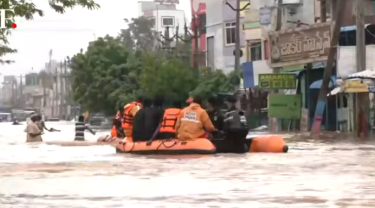
A massive relief operation is in progress in Andhra Pradesh and Telangana after severe floods claimed at least 33 lives and affected millions. The floods were caused by a depression over the Bay of Bengal, bringing unprecedented rain. Andhra Pradesh saw a record 520 millimeters of rainfall in just 24 hours.
The rain, which began on August 30 and intensified until September 3, resulted in heavy flooding. In just 48 hours, over 27% of Andhra Pradesh’s yearly rainfall occurred. This situation worsened due to a rare weather event—a land-based cyclone, which pulled in moisture from both the Arabian Sea and the eastern parts of India.
As floodwaters start to recede in some regions, the full scale of the damage is becoming clear. Satellite data from the European Space Agency’s Sentinel-1 has shown large areas underwater in districts like Khammam, Mahabubnagar, and Suryapet in Telangana, as well as Guntur, Krishna, and Vijayawada in Andhra Pradesh.
The relief effort is massive, involving government agencies, religious groups, and NGOs. The Andhra Pradesh government reports that about 6.44 million people were affected by the heavy rain between August 28 and 31. So far, 42,707 people are staying in 193 relief camps across seven districts, including Nandamuri Taraka Rama Rao, Guntur, Krishna, Eluru, Palnadu, Bapatla, and Prakasam.
The National Disaster Response Force (NDRF) has sent 38 teams to the worst-hit areas. They are focused on rescuing people and giving immediate help. Thousands have been evacuated as roads, bridges, and railways have been severely damaged. A key bridge near Garikapadu, which connects Andhra Pradesh and Telangana, has been particularly damaged, making it harder to deliver aid and supplies.
Religious groups have also stepped in to help. The Vijayawada Catholic Church diocese, through its Social Service Center (SSC), is involved in the rescue and relief efforts. Father Sunil Raju Thota, executive director of the SSC, told UCA News, "Our volunteers are part of the relief and rescue work. We are helping affected people with sanitary kits, dry-ration kits, blankets, towels, study materials, emergency medicines, drinking water, milk, and food packets."
The diocese estimates that over 2,000 families urgently need relief. Priority is being given to vulnerable groups like infants, the elderly, physically challenged people, pregnant women, and those with health problems. Out of the 98 parishes in the diocese, 13 have been affected by the floods.
Caritas India, an NGO, is also playing a key role. Monisha Majumdar, a disaster management official at Caritas, said their team is working with the government on “relief and rescue work,” with a focus on improving water, sanitation, and hygiene in flood-hit areas.
The city of Vijayawada has been particularly hard-hit, receiving 548.40 mm of rain so far this year—far more than its usual 430 mm. This makes it one of the worst natural disasters the city has faced in the last 30 years.
In Telangana, the situation remains serious. Chief Minister Revanth Reddy has asked district officials to clear illegal structures near water bodies to prevent future flooding. He has also called for a system similar to Hyderabad’s Disaster Response and Asset Protection Agency to prevent encroachments and reduce flood risks in the future.
The India Meteorological Department (IMD) has issued warnings for heavy rain in four districts in Telangana—Adilabad, Bhadradri Kothagudem, Khammam, and Mahabubabad—for September 5. Thunderstorms with lightning and strong winds are expected in some areas.
Urban planners and environmentalists have raised concerns that poor infrastructure and unchecked urbanization have worsened the flooding. Faulty stormwater systems, excessive concretization, and lack of rainwater harvesting have made cities more vulnerable to extreme weather.
Shashidhar Shetty, secretary of the National Environment Care Federation (NECF), said, "Rainwater has no place to percolate into the land, as every inch of the road is metalled or lined with concrete or tiles, leaving no place for the earth to take in water. Many cities in the country do not have municipal by-laws directing developers to reserve a certain percentage of the land exclusively for rainwater to enter the earth."
As more rain is predicted, the focus remains on providing immediate aid and developing long-term strategies to prevent such disasters in the future.




